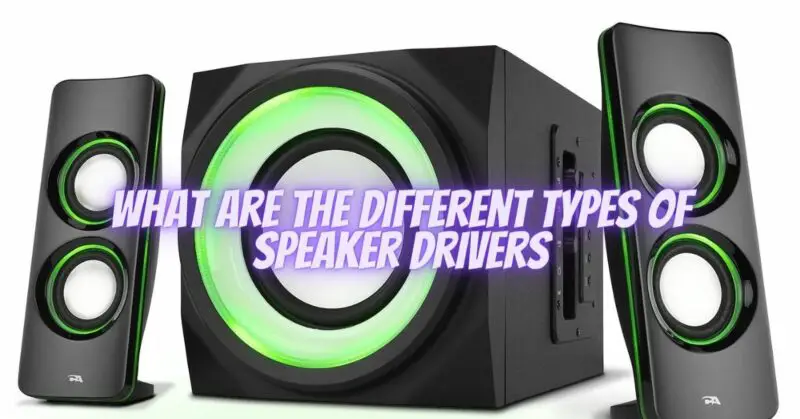Speaker drivers are crucial components responsible for converting electrical signals into sound waves. Each speaker typically comprises multiple drivers, each specialized in reproducing specific frequency ranges. Understanding the different types of speaker drivers and their functions can help you make informed decisions when selecting speakers. In this article, we will explore the various types of speaker drivers commonly used in audio systems and their respective roles in producing accurate and balanced sound reproduction.
- Woofer:
The woofer is responsible for handling low-frequency sounds and producing deep and rich bass notes. Key characteristics include:
a. Size: Woofers are typically larger in diameter to move more air and generate low-frequency response effectively.
b. Cone or diaphragm material: Woofers commonly feature rigid cones made of materials like paper, polypropylene, or composite materials. These materials provide a balance of stiffness and weight to reproduce bass frequencies accurately.
- Midrange Driver:
The midrange driver handles frequencies in the middle range, including vocals, instruments, and other midrange elements. Key characteristics include:
a. Size: Midrange drivers are smaller in diameter compared to woofers, allowing for better control over midrange frequencies.
b. Cone or diaphragm material: Midrange drivers often employ materials similar to woofers, but with different construction to optimize midrange performance, accuracy, and detail.
- Tweeter:
The tweeter is responsible for reproducing high-frequency sounds, ensuring clarity and detail in audio reproduction. Key characteristics include:
a. Size: Tweeters are smaller than woofers and midrange drivers, allowing for the accurate reproduction of high-frequency content.
b. Dome or diaphragm material: Tweeters commonly use soft dome materials like silk, fabric, or synthetic materials, as well as hard materials like metal or ceramics. These materials provide a lightweight and responsive diaphragm to reproduce high frequencies with accuracy and precision.
- Supertweeter:
Some speaker systems may include a supertweeter, which handles ultra-high frequencies beyond the range of standard tweeters. Key characteristics include:
a. Size: Supertweeters are even smaller than tweeters and designed to handle frequencies above the audible range for humans.
b. Dome or diaphragm material: Similar to tweeters, supertweeters utilize lightweight dome materials to accurately reproduce ultra-high frequencies.
- Subwoofer:
A subwoofer is a specialized driver dedicated solely to reproducing extremely low-frequency content. Key characteristics include:
a. Large size: Subwoofers are typically larger in size than woofers, allowing them to move larger amounts of air and generate deep bass with impact.
b. Low-pass filter: Subwoofers often have built-in low-pass filters to ensure they only reproduce the lowest frequencies, complementing the main speakers’ output.
- Passive Radiator:
A passive radiator is a driver without a voice coil or magnet, used to enhance bass response. It resonates in response to air pressure changes created by other drivers, producing additional low-frequency output.
- Horn Driver:
Horn drivers employ a horn-shaped enclosure that improves efficiency and allows for increased sound pressure levels. Horn drivers are commonly used in professional audio systems and can be found in public address systems, live performances, and cinemas.
Conclusion:
Understanding the different types of speaker drivers is essential for evaluating and selecting speakers that suit your audio preferences. Woofers, midrange drivers, tweeters, and supertweeters work together to reproduce a wide frequency range, ensuring accurate and balanced sound reproduction. Subwoofers and passive radiators specialize in handling low frequencies, while horn drivers enhance efficiency and sound pressure levels. By considering the characteristics of each driver type, you can choose speakers that provide the desired frequency response, clarity, and overall audio performance for your listening enjoyment.


